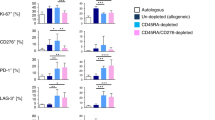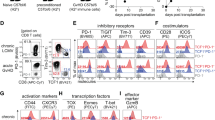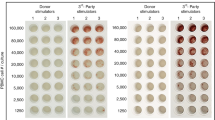Abstract
Graft-versus-host disease (GVHD) is a major source of morbidity in allogenic stem cell transplantation1. We previously showed that recipient antigen-presenting cells (APCs) are required for CD8-dependent GVHD in a mouse model across only minor histocompatibility antigens (minor H antigens)2. However, these studies did not address the function of donor-derived APCs after GVHD is initiated. Here we show that GVHD develops in recipients of donor major histocompatibility complex class I–deficient (MHC I−) bone marrow. Thus, after initial priming, CD8 cells caused GVHD without a further requirement for hematopoietic APCs, indicating that host APCs are necessary and sufficient for GHVD. Nonetheless, GVHD was less severe in recipients of MHC I− bone marrow. Therefore, once initiated, GVHD is intensified by donor-derived cells, most probably donor APCs cross-priming alloreactive CD8 cells. Nevertheless, donor APCs were not required for CD8-mediated graft-versus-leukemia (GVL) against a mouse model of chronic-phase chronic myelogenous leukemia. These studies identify donor APCs as a new target for treating GVHD, which may preserve GVL.
This is a preview of subscription content, access via your institution
Access options
Subscribe to this journal
Receive 12 print issues and online access
$209.00 per year
only $17.42 per issue
Buy this article
- Purchase on Springer Link
- Instant access to full article PDF
Prices may be subject to local taxes which are calculated during checkout




Similar content being viewed by others
References
Goker, H., Haznedaroglu, I.C. & Chao, N.J. Acute graft-vs-host disease: Pathobiology and management. Exp. Hematol. 29, 259–277 (2001).
Shlomchik, W.D. et al. Prevention of graft versus host disease by inactivation of host antigen-presenting cells. Science 285, 412–415 (1999).
Bland, P.W. & Whiting, C.V. Induction of MHC class II gene products in rat intestinal epithelium during graft-versus-host disease and effects on the immune function of the epithelium. Immunology 75, 366–371 (1992).
Matte, C.C. et al. Graft-versus-leukemia in a retrovirally induced murine CML model: mechanisms of T-cell killing. Blood 103, 4353–4361 (2004).
Pear, W.S. et al. Efficient and rapid induction of a chronic myelogenous leukemia-like myeloproliferative disease in mice receiving P210 bcr/abl-transduced bone marrow. Blood 92, 3780–3792 (1998).
Daley, G.Q., Van Etten, R.A. & Baltimore, D. Induction of chronic myelogenous leukemia in mice by the P210bcr/abl gene of the Philadelphia chromosome. Science 247, 824–830 (1990).
Kaech, S.M. & Ahmed, R. Memory CD8+ T cell differentiation: initial antigen encounter triggers a developmental program in naive cells. Nat. Immunol. 2, 415–422 (2001).
van Stipdonk, M.J., Lemmens, E.E. & Schoenberger, S.P. Naive CTLs require a single brief period of antigenic stimulation for clonal expansion and differentiation. Nat. Immunol. 2, 423–429 (2001).
Mintern, J.D. et al. Cutting edge: precursor frequency affects the helper dependence of cytotoxic T cells. J. Immunol. 168, 977–980 (2002).
Iezzi, G., Karjalainen, K. & Lanzavecchia, A. The duration of antigenic stimulation determines the fate of naive and effector T cells. Immunity 8, 89–95 (1998).
Croft, M., Bradley, L.M. & Swain, S.L. Naive versus memory CD4 T cell response to antigen. Memory cells are less dependent on accessory cell costimulation and can respond to many antigen-presenting cell types including resting B cells. J. Immunol. 152, 2675–2685 (1994).
Kedl, R.M. & Mescher, M.F. Qualitative differences between naive and memory T cells make a major contribution to the more rapid and efficient memory CD8+ T cell response. J. Immunol. 161, 674–683 (1998).
Zimmermann, C., Prevost-Blondel, A., Blaser, C. & Pircher, H. Kinetics of the response of naive and memory CD8 T cells to antigen: similarities and differences. Eur. J. Immunol. 29, 284–290 (1999).
Cho, B.K., Wang, C., Sugawa, S., Eisen, H.N. & Chen, J. Functional differences between memory and naive CD8 T cells. Proc. Natl. Acad. Sci. USA 96, 2976–2981 (1999).
London, C.A., Lodge, M.P. & Abbas, A.K. Functional responses and costimulator dependence of memory CD4+ T cells. J. Immunol. 164, 265–72 (2000).
Sprent, J. T memory cells: quality not quantity. Curr. Biol. 12, R174–R176 (2002).
Le Bon, A. et al. Cross-priming of CD8(+) T cells stimulated by virus-induced type I interferon. Nat. Immunol. 4, 1009–1015 (2003).
Singh-Jasuja, H. et al. The heat shock protein gp96 induces maturation of dendritic cells and down-regulation of its receptor. Eur. J. Immunol. 30, 2211–2215 (2000).
Hu, H.M. et al. CD28, TNF receptor, and IL-12 are critical for CD4-independent cross-priming of therapeutic antitumor CD8+ T cells. J. Immunol. 169, 4897–4904 (2002).
Hoffmann, T.K., Meidenbauer, N., Muller-Berghaus, J., Storkus, W.J. & Whiteside, T.L. Proinflammatory cytokines and CD40 ligand enhance cross-presentation and cross-priming capability of human dendritic cells internalizing apoptotic cancer cells. J. Immunother. 24, 162–171 (2001).
Kopp, E. & Medzhitov, R. Recognition of microbial infection by Toll-like receptors. Curr. Opin. Immunol. 15, 396–401 (2003).
Horowitz, M.M. et al. Graft-versus-leukemia reactions after bone marrow transplantation. Blood 75, 555–562 (1990).
Kolb, H.J. et al. Graft-versus-leukemia effect of donor lymphocyte transfusions in marrow grafted patients. European Group for Blood and Marrow Transplantation Working Party Chronic Leukemia. Blood 86, 2041–2050 (1995).
Choudhury, A. et al. Use of leukemic dendritic cells for the generation of antileukemic cellular cytotoxicity against Philadelphia chromosome-positive chronic myelogenous leukemia. Blood 89, 1133–1142 (1997).
Chakrabarti, S. et al. High incidence of cytomegalovirus infection after nonmyeloablative stem cell transplantation: potential role of Campath-1H in delaying immune reconstitution. Blood 99, 4357–4363 (2002).
Cragg, L. et al. A randomized trial comparing prednisone with antithymocyte globulin/prednisone as an initial systemic therapy for moderately severe acute graft-versus-host disease. Biol. Blood Marrow Transplant. 6, 441–447 (2000).
Bix, M. et al. Rejection of class I MHC-deficient haemopoietic cells by irradiated MHC-matched mice. Nature 349, 329–331 (1991).
Anderson, B.E. et al. Memory CD4+ T cells do not induce graft-versus-host disease. J. Clin. Invest. 112, 101–108 (2003).
Pear, W.S., Nolan, G.P., Scott, M.L. & Baltimore, D. Production of high-titer helper-free retroviruses by transient transfection. Proc. Natl. Acad. Sci. USA 90, 8392–8396 (1993).
Acknowledgements
We thank M. Shlomchik for discussions and reading of the manuscript. This work was supported by National Institutes of Health RO1 grants CA96943 and HL66279. W.D.S. was supported by National Institutes of Health grant K08 HL03979 and B.E.A. was supported by National Institutes of Health grant T32 AI071019-23-25.
Author information
Authors and Affiliations
Corresponding author
Ethics declarations
Competing interests
The authors declare no competing financial interests.
Rights and permissions
About this article
Cite this article
Matte, C., Liu, J., Cormier, J. et al. Donor APCs are required for maximal GVHD but not for GVL. Nat Med 10, 987–992 (2004). https://doi.org/10.1038/nm1089
Received:
Accepted:
Published:
Issue Date:
DOI: https://doi.org/10.1038/nm1089
This article is cited by
-
Acute graft-versus-host disease
Nature Reviews Disease Primers (2023)
-
Defining a TCF1-expressing progenitor allogeneic CD8+ T cell subset in acute graft-versus-host disease
Nature Communications (2023)
-
S1P/S1PR1 signaling differentially regulates the allogeneic response of CD4 and CD8 T cells by modulating mitochondrial fission
Cellular & Molecular Immunology (2022)
-
Dissecting the biology of allogeneic HSCT to enhance the GvT effect whilst minimizing GvHD
Nature Reviews Clinical Oncology (2020)
-
Alloantigen expression on malignant cells and healthy host tissue influences graft-versus-tumor reactions after allogeneic hematopoietic stem cell transplantation
Bone Marrow Transplantation (2018)



